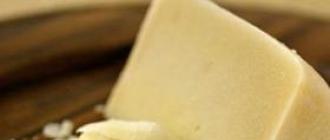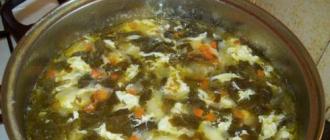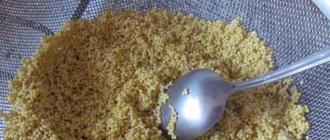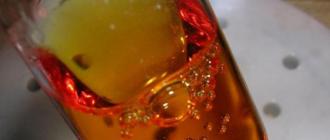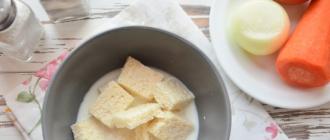It is known that cooking is the most ancient art, and pilaf is one of the oldest dishes prepared by man. The first recipes for this dish appeared simultaneously with the period when people began to cultivate grain crops. There is a famous saying in Turkey that there are as many recipes for this treat as there are cities in the Muslim world. In the East there are other proverbs and folk sayings associated with this dish. However, even in this diversity there are recipes that can rightfully be called masterpieces of world cuisine. Shah pilaf is generally recognized as one of these amazing dishes - a royal dish worthy of the most solemn event.

Baku pilaf with dried fruits has long gained immense popularity all over the world and still remains the main dish of Azerbaijani cuisine. It is impossible to imagine any special event in this eastern country without khan pilaf.
It is prepared for weddings and birthdays, and placed on the table when meeting close friends.
An incredibly tasty and stunningly beautiful treat always takes pride of place at the feast. The peculiarity of this dish is that when served it looks more like a delicious pie than traditional pilaf. Rice with meat and dried fruits is inside a royal crown made of dough.

There are several recipes for Azerbaijani Shah pilaf: it can be cooked with meat, with fruits or with a combined filling. Regardless of the composition and main components of this treat, its form always remains the same. All products are inside a thin dough, which is baked until golden brown.

Ingredients
Azerbaijani royal pilaf is usually prepared from young lamb meat. If desired, it can be replaced with any poultry or veal. Shah pilaf can also be prepared in a sweet version, without adding meat at all, but this will no longer be a classic recipe, but one of its variations.

To prepare 6 servings you will need:
- Lamb - 1 kg;
- Devzira or basmati rice - 1 kg;
- Butter - 3-4 tbsp. l.;
- Onions - 1-2 pcs.;
- Carrots - 2 pcs.;
- Dried fruits, raisins, chestnuts, dried apricots - 350 g;
- Salt - to taste.

For the test:
- Flour - 2 cups;
- Ghee - 150 g;
- Water - 1/2 cup;
- Salt - a pinch.
How to cook Shah pilaf
Before preparing pilaf, preheat the oven well, otherwise it may turn out dry.
The classic Shah pilaf is decorated with ruddy gazmah - a thin, delicate dough crust, but in some versions you can prepare this dish using thin pita bread. To make a treat according to a real Azerbaijani recipe, first of all, gazmah is prepared from flour, oil and water. 
Place the oil in a convenient container and heat it well. When the butter has cooled to room temperature, add salt, flour and water and knead into a soft, elastic dough. You can find out what consistency the dough for gazmakh should be by looking at the recipe with a photo. Wrap the resulting dough in a plastic bag and set aside for 40 minutes until it becomes smooth and pliable. After this, you can divide it into several small parts, roll it into a thin layer and place it in a baking dish for pilaf. 
Step-by-step recipe for Shah pilaf
Cooking royal pilaf step by step in the oven will help even a beginner make a tasty treat. Unlike classic cooking options, when using a cast iron casserole, you can use any baking dish. It is better if it has a round shape, then it will have the traditional appearance of a large pie or the crown of a Shah (king).
Shah pilaf in Azerbaijani does not require the preparation of zirvak - meat gravy with vegetables and spices.
Separately, cook the rice in lightly salted water. After the grains are half cooked, carefully drain the water through a strainer or colander, leave the grains for 10-15 minutes to cool slightly. You can cook rice cereal in bags, then put it on a plate in which it will have to cool to room temperature. 

Rice should be cooked in plenty of water so that the grains will not stick to each other. Heat the water separately and after cooking, rinse the cereal well and let the excess water drain. Heat some of the melted butter until it is slightly warmer than room temperature. Place the rice in an even layer on the prepared dough and coat it well with oil.
When making a large portion, you can lay out the rice in several layers, each of which should be lightly oiled.
It is not recommended to stir the cereal; it should lie in an even but loose layer. Don't forget to oil the mold in which the dough is placed. If thin pita bread is used for the crust, it should be spread on a table or cutting board and cut into several thin strips, 5-6 centimeters wide. 
Preparing the filling for Khan's pilaf
Let's prepare the filling with which we will fill the royal pilaf in pita bread (or dough).
Cut the meat across the grain into medium pieces 3-4 centimeters wide. Place pieces of tail fat in a dry frying pan and render the fat well (the cracklings must be removed so that they do not give the finished treat the taste of burnt meat). Add a piece of butter and, when it is well heated, add the prepared lamb to the fat. You can replace it with young veal. When the meat is fried until golden brown, cover it with a lid and reduce the heat so that it simmers slightly and becomes softer. Place it on a separate plate. 
Peel the onion, chop it into thin rings and fry until soft in hot oil. Add cumin, spices and a little salt, stir. Chop the carrots into strips, add them to the onions, stir and let them brown slightly for 1-2 minutes. Add the fried meat, the rest of the dried fruits, spices and seasonings and simmer for another 5-10 minutes, you can add a little water if necessary. Cook until the liquid evaporates; place the filling on the rice.
This pilaf recipe can be changed by removing meat and vegetables from the ingredients, and adding a little honey or sugar syrup instead of salt and spices. This way you will get another wonderful treat - sweet pilaf made from dried fruits.
Spread the filling over the entire surface and carefully fold the edges of the dough so that it completely covers the contents of the mold. If necessary, trim off excess dough from edges. If you are using pita bread, wrap the strips clockwise, overlapping them. Place the pilaf in the oven and cook for 50 minutes at a temperature of 150-160 degrees. 
When the crust is slightly dry, remove the pan and grease with the remaining piece of butter. For even oiling, it is better to use a pastry brush. Increase the temperature to 180 degrees and bring the treat until fully cooked (the top crust should be a beautiful golden color). 

It is recommended to serve pilaf on a round or oval-shaped dish, cutting the dough into 8-12 pieces in a circle into equal sectors (like a cake). Carefully bend the edges of the dough to make a semblance of a crown and serve the royal treat to the table. 
The traditions of the Azerbaijani people are inextricably linked with national cuisine. There are many recipes for khan pilaf - every city and village has its own specific way of preparing this wonderful treat. However, there are certain rules that every cook adheres to. According to legend, it is thanks to special subtleties that only folk pilaf makers know about that a real culinary masterpiece worthy of a royal table is obtained.
- Instead of bread, pilaf is served with pieces of fried crust, which can be carefully cut off before serving the dish. If the treat is being prepared for a large number of guests, it is cut into equal triangular pieces, after which the filling can be placed in heaps on a plate, and pieces of fried pita bread or dough can be used instead of bread.
- To give the rice a beautiful yellow hue, you can add a pinch of turmeric or saffron to the water during cooking. If saffron is used, it is enough to add 1-2 thin threads. Since the spice has a rather specific taste, it needs to be added in small quantities, otherwise the aroma of rice will overpower the smell and aroma of other components.


- The most suitable utensil for preparing any pilaf has always been considered a cast iron cauldron. However, in this case, it is best to prepare the treat in a round baking dish (you can use a mold for jellied pies or sponge cakes; a cast iron frying pan with a removable handle is suitable. However, please note that the bottom and walls of the dish must be thick so that the crust fries but does not burn .
- At home, you can make a dish for 6-8 servings using a convenient kitchen appliance - a multicooker. Using this modern device, it is best to use ready-made thin pita bread instead of dough. The dish is prepared in the pilaf mode for 40 minutes, after which it is carefully turned over and brought to readiness for another 20 minutes. This way the treat will have a beautiful golden brown crust on both sides.

- In the homeland of this wonderful treat, in Baku, the festive dish is prepared in a wood-burning oven. In urban conditions, it can be prepared in both an electric and gas oven. In order for the dish to be ready, but not burnt, it is important to change the temperature regime in time. For the first 40 minutes, pilaf is cooked at +130°C-+150°C, after which it is increased to 180°C.
- When cutting the top crust, be careful not to press on the rice filling. For convenience, you can take culinary scissors, carefully pierce the crust in the middle and move towards the edges. After the entire upper part is divided into sectors, carefully open the resulting petals as well, from the middle to the edge. Before serving, you can add fresh pomegranate seeds on top of the filling - this will make it look even more impressive.
- You can use more than just meat and fruit as a filling. If desired, you can prepare sweet pilaf from dried apricots, nuts and prunes. In some cases, it is prepared only from rice. In this case, all spices and seasonings are added to the water in which the cereal is cooked.

- If poultry is used for the filling, it is pre-marinated. This makes the meat more juicy and flavorful. The simplest version of marinade for chicken or turkey: ripe tomatoes are crushed into puree, a few drops of vegetable oil, salt and spices are added. Place the meat in the tomato marinade (preferably in a large piece) and leave for 3-4 hours. Before frying, the meat is cut into portions. Marinade can be added to stew meat.
Shah pilaf in Azerbaijani style
Shah Ash - Royal Pilaf! (Khan-pilaf). Photo recipe.
(Azerbaijani cuisine)
This is simply incredibly delicious pilaf - aromatic and tender,
fluffy rice soaked in oil, soft meat,
and the fruits give a sort of sweet and sour accent.
Ingredients:
lamb or beef - 800 gr
rice - 800 gr.
thin lavash - 3-4 packages of 70 gr.
butter - 600 gr.
onion - 1 pc.
apricots - 200 gr.
raisins - 150 gr.
chestnuts 150 gr. (I don’t have chestnuts)
dried cherry plum - 150 gr. (I don’t have cherry plum)
turmeric, salt, spices for pilaf

Preparation:
First of all, I want to say that everything should be the best.
Ideally: Indonesian basmati type rice, apricots and raisins
shadow drying and preferably seedless
(I found a dried one on sale, absolutely delicious!), you can use cherry plum
add it or not (cherry plum gives a well-perceptible sourness
kind of like babrberry, it's not for everyone. and here, in the Urals,
it is not on sale at all), also for cooking
a thick-walled roasting pan is required - ideally a round cast iron casserole,
but any roasting pan made of thick cast aluminum will do.
I have a 6-liter vertical (for city stoves, like a saucepan)
cauldron made of cast aluminum.
So, first of all, wash the rice (I washed it for a couple of minutes
on a sieve) and soak in lukewarm salt n noah water
for at least 30 minutes.

Then drain the water and add a teaspoon of turmeric
and a tablespoon of vegetable oil.

Fill with fresh cold water and bring to a boil
and boil the rice until half cooked (See on the package
your rice. If it says to cook for 20 minutes, it means cook for 10 minutes).
Place the rice in a sieve to drain excess water.
While the rice is cooking, cut the meat into small pieces
(for example, cubes),

Then melt 50 grams of butter in a frying pan,

Fry the meat until golden brown, add chopped
dice the onion and fry for another 5-7 minutes, add salt, pepper, and remove from heat.

Set aside 70 grams (less than half a pack) of butter
to lubricate the cauldron, melt the rest of the butter
(ideally, we heat it in a water bath. I’m lazy, I just melted it on fire).

Pour boiling water over apricots and raisins for 5-10 minutes, depending
depending on the degree of drying, drain the water.
Now we are collecting our Shah-pilaf.
Grease the casserole generously with oil.

We line the cauldron with strips of lavash so that at the bottom
they overlapped and the edges hung down.
Drizzle the bottom with a few tablespoons of melted butter.

Add a third of the rice. Drizzle with oil
sprinkle with spices (carefully with the spices, a little at a time!).

Place meat on rice.

Place a third of the rice on the meat again, pour oil over it,
a little spice, and put raisins and apricots on top.

Place the remaining rice on top, pour oil over it,
a little spice.

Cover the rice with the hanging ends of the pita strips,
pour in the remaining oil.

Cover the cauldron with a lid and place in the oven.
preheated to 180 degrees, for 1-1.5 hours.
Readiness is determined by a beautiful golden brown crust.
I didn’t look in the oven at all for an hour, then I looked -
it seemed that the crust was not brown enough -
Left it in the oven for another 15 minutes.
When ready, remove the cauldron from the oven,
remove the cover - this is what it looked like for me:

Holding the pilaf with a spatula, pour over the edge of the cauldron
oil (there won’t be much of it, but there will be some), then
turn the cauldron onto a plate.
Cut into petals using a sharp knife. Do not wait,
what is this casserole, this is a real crumbly pilaf,
it just sprinkles onto the dish!

I like to cook pilaf, so I’m happy to add these recipes to my repertoire. If you like it, cook it with pleasure.
INGREDIENTS
Medium grain rice “Italica” (“Mistral”) - 300 gr.
Armenian lavash - 2 pcs. (I have “Wheat roll for making rolls” 1.5 sheets)
Meat (chicken, lamb) - 500 gr.
Onion - 2 pcs. (medium size)
Butter - 70 gr.
Dried apricots - 100 gr.
Raisins - 50 gr.
Garlic - 3-4 cloves
A pinch of saffron
A pinch of turmeric
Spices for pilaf or a mixture of spices: salt, pepper, cumin, barberry, paprika
Vegetable oil for frying meat
_______ _________ _________
HOW TO COOK
Rinse the rice. Place in a saucepan in layers (1 cm thick), topped with thin slices of butter. Add salt (to taste), a pinch of saffron and turmeric. Pour water into the rice in a ratio of 1:2 and cook until done.
Meanwhile, cut the meat into small pieces and fry until golden brown in vegetable oil.
Cut the onion into small cubes and add to the meat. Fry for 5-7 minutes.
Soak raisins and dried apricots in boiling water for 5 minutes. Then cut the dried apricots into small pieces. Add raisins, dried apricots and spices to the meat, stir. Simmer for 2-3 minutes.
Chop the garlic and add to the mixture removed from the heat. Mix.
Cut the pita bread into strips approximately 5 cm wide.
Melt the butter. Grease the cauldron (baking dish) with it. Place strips of pita bread in the shape of a fan (overlapping), while brushing them with melted butter. It is necessary to leave the hanging parts of the pita bread.

Place a layer of rice on the bottom. Then add a layer of meat. Alternately add all the rice and meat.

Cover the rice with the hanging parts of the pita bread and brush with oil. Cover the top of the cauldron with foil.
Bake in a preheated oven for 40-45 minutes at 160 degrees. 15-20 minutes before the end, remove the foil.
Place pilaf from the cauldron onto a dish. Cut the resulting “pilaf cake” into portions using a sharp knife!
Vegetarian Azerbaijani Shah-pilaf with dried fruits in lavash No. 1
The highlight of pilaf is that it is cooked with dried fruits, including raisins, but it is salty - and of course there is no meat in it at all! Plus, it's served very festively - baked in sheets of pita bread like a cake - it's not for nothing that it's a traditional wedding dish in its homeland. And here's how to prepare it - a step-by-step recipe with photos.
Ingredients
Basmati rice - 0.5 kg
Raisins - 150 gr
Dried apricots - 150 gr
Cherry plum/dogwood (or other dried fruit with a sour taste) - 150g
Walnut - 250 gr.
Carrots - 3 medium pieces
Butter - 1 pack 200 g
Thin lavash - 1-2 pack
Cooking instructions
The secret of proper Azerbaijani pilaf is properly cooked rice. Basmati is used for pilaf (the longer the grain, the better). The rice must be soaked for half an hour in plenty of cold water and then rinsed well under running cold water until the water becomes clear. After the rice is washed, pour 3 times more boiling water, add salt and cook for about 3-5 minutes. The rice should be cooked until al dente - so that the inside of the rice is uniform in color, but still tastes raw. Place the rice with all the excess liquid in a sieve/small colander and pour boiling water over it and leave to drain in the sieve. It is ready for further preparation of pilaf.
Wash the dried fruits, dry them and cut them into small pieces (of course, you don’t need to cut the raisins). Melt a third of a stick of butter in a frying pan and start sauteing the chopped dried fruits, after a few minutes add 2 tablespoons of sugar and a little salt to them so that they seem to caramelize a little (this will happen literally a few minutes after adding the sugar). Turn off the pan.
Cut the carrots into small cubes and sauté in vegetable oil until almost done. Add salt.
Break the walnut into pieces and fry a little in a dry frying pan.
Cut the pita bread into long strips about 5-6 cm wide. Melt the remaining butter. Now you can start shaping the pilaf itself.
In a deep form with a wide diameter (preferably a thick-bottomed cauldron or frying pan), lay out the strips of lavash overlapping, greasing with oil. Let the remaining length of the pita bread hang down on the sides - we will cover the top of the pilaf with them. When the entire surface of the bottom and sides is covered with 2 layers of pita bread, it’s time to stop and start putting the ingredients inside.
The first layer is rice (no more than 1 cm thick), evenly distribute dried fruits on it. Drizzle a little melted butter over everything. Rice again, evenly distribute carrots and walnuts over it. Drizzle with a little oil. And so on until you run out of ingredients or the height of the frying pan - finish with rice.
Cover the top of the rice with strips of pita bread, tucking them in on the other side. Brush the top of the pita bread with the remaining oil.
Place the pan in a preheated oven at 200 degrees for 20-30 minutes until the pita bread is golden brown.
After our vegetarian pilaf is “baked”, it must be turned out of the frying pan onto a festive dish and served. You can cut it in front of guests - it turns out very impressive!
Vegetarian Azerbaijani Shah-pilaf with dried fruits in lavash No. 2
Cooking time: 1 hour 10 minutes.
Preparation time: 1 hour 20 minutes.
Number of servings: 10 pcs.
Ingredients for the Shah-pilaf recipe:
Dry barberry 20 gWater 640 ml
Zira (Cumin) dry 1 tsp. Light raisins 20 g
Dark raisins 50 g Dry coriander 1 tsp.
Dried apricots 100 g Chicken drumstick 350 g
Turmeric 1 tsp. Thin lavash 1 pc.
Onions 2 pcs. Refined olive oil 2 tbsp. l.
Butter 70 g Ghee 40 g
Carrots 1 pc. Basmati rice 250 g
Salt 1 tsp. Dried dates 100 pcs.
Garlic 3 cloves
Cooking Shah-pilaf in lavash in Azerbaijani style
Lavash is a very popular ingredient for preparing snacks, salads, and baked goods. Today, lavash serves as a cauldron in which pilaf is prepared. The pilaf retains its juiciness, does not burn, and gets a crispy crust thanks to the lavash. Lavash is like a huge kazm around the whole pilaf. I am pleased to announce that the recipe for this pilaf in lavash was invented by the Azerbaijani chef Shah-Huseyn Kerimov.
Of course, I want to focus on the type of rice. Basmati rice should have a dense grain (the first time I took the rice it was small and thin - it was overcooked). A very diverse set of dried fruits enhances the taste and appearance of pilaf. Chicken meat should be taken from the thigh part, because... Breast meat does not provide juiciness. I used thin lavash. The result is a crispy top layer, like baked phyllo dough. Learn how to make phyllo dough recipe.
How to prepare a dish step by step with photos at home
1. To prepare pilaf, you need to take Armenian lavash, rice, chicken, carrots, onions, garlic, raisins, dried apricots, dates, raisins, barberries, cumin, turmeric, salt, coriander, water.
2. Rinse the rice in seven waters, add water and set aside.
3. Rinse raisins, dried apricots, dates under running water. Cut dried apricots and dates (I used pitted ones) into strips.
4. Pour hot water over the prepared dried fruits. Set aside.
5. Peel the onion. Cut into cubes. Sauté over medium heat in 1 tbsp olive oil. until transparent, stirring.
6. Peel and wash the carrots. Cut into thin bars. Add to onion. Continue frying over medium heat.
7. Pour 1 tbsp of ghee into the multicooker bowl (I have a Panasonic multicooker). Add prepared rice.
8. Pour cold water over the rice. Add salt. Place the bowl in the multicooker. Close the lid. Turn on the “Buckwheat” cooking mode. The time is set automatically. Wait for the sound signal. During cooking, the water will evaporate.
9. The rice is ready. Pour, diluted in 2 tbsp. boiling water, turmeric. Add 1 tbsp. ghee. Place on warm mode for 10 minutes.
10. Wash the meat. Dry with a napkin. Fry for 1 tbsp. olive oil over high heat.
11. Add spices and barberries to the fried onions and carrots. Mix. Keep on fire for 1 minute.
12. Add vegetables with spices to the fried meat. Keep on fire for another 2-3 minutes, stirring. Remove from heat. And then add the prepared dried fruits. Chop the garlic. Add to main dish. Mix. Set aside.
13. Carefully place the finished rice (so as not to break the grains) with the meat with vegetables, spices and dried fruits.
14. The filling is ready.
15. Cut the pita bread into strips 5 cm wide, and the length should be such that the strip can cover the height of the mold.
16. Grease each strip with soft butter on one side.
17. Grease the walls and bottom of the mold with butter. Place strips of pita bread in succession with butter against the side of the mold.
18. Place the filling into the mold.
19. Cover the filling tightly with strips. Place pieces of butter on top. Place in a hot oven. Bake for 50 minutes - 1 hour 10 minutes at 180ºC until golden brown.
20. Cool the finished pilaf briefly in the mold and immediately remove it to a dish so that the crust remains crispy.
Vegetarian Azerbaijani Shah-pilaf with dried fruits in lavash
Dancing from the stove to the computer!! Source Website "Delicious with Love" I will be very glad to join!! http://holomonova.mirtesen.ru/
Azerbaijani cuisine
This is simply incredibly delicious pilaf - aromatic and tender, the rice is crumbly, soaked in butter, the meat melts in your mouth, the fruits add a sweet and sour accent.
Ingredients:
Lamb or beef or pork - 600 -700 g, Rice - Basmati - 1 glass, Butter - 100 g, Onion - 1 pc., Carrot - 1 pc., Bell pepper 1/2 pcs., Uryuk, raisins, cherry plum (barberry), chestnuts are desirable and very tasty. I replaced it with Brazil nuts -6 pieces, turmeric, salt, spices for pilaf
Preparation:
Apricots and raisins, preferably seedless, cherry plums or barberries add a distinct sourness.
Wash the rice and cook until half cooked, before finishing, add a little turmeric to the rice, according to your taste, you don’t need a lot, otherwise the rice will taste bitter and the color will be ultra yellow and bright. Place in a sieve and let the water drain. Transfer to a separate bowl and add 50g butter.
We cut the meat into regular small pieces, just like you cut it into pilaf. We prepare the meat as for regular pilaf. In a preheated frying pan or cauldron, melt the fat tail fat or heat the butter.
Place meat in heated oil or fat, fry until golden brown, add salt and pepper, remove from heat. Add spices.
In a separate pan, fry onions, carrots, and bell peppers. Fry and remove from heat.
Pour boiling water over the apricots and raisins for 5-10 minutes, depending on the degree of drying, drain the water.
Let's collect our Shah-pilaf.
Grease the casserole generously with oil.
Line the cauldron with rolled out dough.
Drizzle the bottom with a few tablespoons of melted butter.
Lay out some of the rice. Raisins, dried apricots, cherry plums. Drizzle with oil and sprinkle with spices (be careful with the spices, just a little!). Place meat on rice.
Place a third of the rice on the meat again, pour oil, a little spice, and place raisins and apricots on top.
Place the remaining rice on top, pour oil, add some spices.
Cover with dough and pour in oil. I kneaded the dough as for dumplings, 50/50, with sour cream and kefir 1/2 cup sour cream, 1/2 cup kefir, added salt, 2 cups flour and added 2 zhmenki.
Close the cauldron with a lid and place in the oven, preheated to 180 degrees, for 1-1.5 hours.
Holding the pilaf with a spatula, pour the oil over the edge of the cauldron (there will be little of it, but there will be some), then turn the cauldron onto a dish.
Cut into petals using a sharp knife. Don’t think, it won’t be a casserole, this is a real crumbly pilaf, it just wakes up on the dish!
It just so happens that every post of mine attracts many new readers. And, as a rule, these people are new to cooking.
And I know that they will say about this pilaf in advance: “Since there is no meat and carrots here, then this is not pilaf, but porridge!”
I’m not even offended by them, so what if people don’t yet know something interesting that can brighten their lives and diversify the table?

I just have to tell everything from the beginning every time! For example, talk about the fact that more than half of the world's pilafs are cooked separately, that is, rice is cooked separately, and everything else is cooked separately. And every time it all starts with boiling water three to four times larger in volume than the volume of rice.
Everything is exactly the same as when boiling pasta: say, for a kilogram of dry rice, take five liters of boiling water and five tablespoons of salt. Only the rice must be soaked before boiling in warm, up to 60C, salted water - did you know about this?
And so, the rice is cooked to the desired degree of readiness. It's very simple because it's very difficult to make a mistake with this method!

When the rice is ready, pour the water into a large colander or sieve and allow all the water to drain. Next, this rice is transferred to a cauldron and the second stage of preparing pilaf begins - steaming the rice. Most often at this stage the bottom of the cauldron is laid out with thinly rolled dough. The fact is that when the dough is fried, it is very tasty, and when the rice burns, the smell from it spreads throughout the entire cauldron.

Everyone loves the dough crust that forms at the bottom of the cauldron. Usually it’s not even enough, the kids fight over it! And this love led to the invention of a new pilaf called “Khan-pilaf”. Its essence is that rice is wrapped in thin dough and baked in this form.
Usually the point of steaming is that some of the water from the rice evaporates and is absorbed by a napkin under the lid. Here the dough itself absorbs excess moisture and, in addition, decorates the rice itself with its smell.

So that the dough does not dry out and burn, but is fried deliciously, it is greased with melted butter.

The mold itself is greased with melted butter.
You can take any shape, even thin metal will do. But in this case, you need to very carefully choose the temperature of the oven where the pilaf is cooked in the second stage. For example, at a temperature of 130C the dough will definitely not burn, but the pilaf will warm up and the dough will turn brown only after at least 4 hours.

Another thing is the ceramic mold! The properties of ceramics are such that it conducts heat very slowly and, accordingly, very slowly transfers it to products that come into contact with it. The rate at which heat passes through ceramics is as close as possible to the thermal conductivity of the products themselves. This is why food cooked in ceramic dishes can be so delicious!

Shake the rice and place it in the mold. It is necessary that the rice should not lie compacted, but freely - so that steam can circulate among the grains of rice.

If you have saffron, it would be good to grind it in a mortar with salt or sugar and pour boiling water over it to infuse.

The saffron infusion should be poured over the rice now, and not later, as is done in traditional folding pilafs.

And ghee should be added to the rice now, not later. Although later it would be more correct - when the rice dries, there will be free pores in it, into which the oil will be absorbed very easily. But I have an idea for this!

That’s it, the pilaf is closed, but you don’t have to worry too much about the tightness.

Do you understand, yes, that this mold was actually made for something else, for baking bread? I showed how this form works the other day. And here I use it “upside down”, but only at the first stage. After about 40 minutes at a temperature of 160C, the bottom of the kazmakh (dough around the rice) was already browned. Then I turned this form over, the dough and rice sank to the bottom and in 20 minutes the other, already heated part of the dough also browned.

Do you understand what was happening with the oil at this time? First, the oil melted and sank down, sliding over the rice, which was not yet quite ready to receive the oil.
And then, when I turned the pilaf over, the oil flowed over the rice again. But this time the rice was already dry and readily absorbed the oil.

As a result, all the oil ended up inside the rice. After all, what is pilaf? Pilaf is rice cooked in two or more stages and soaked in oil. If the oil is flavored with other products, then the taste and aroma of these products passes into the rice. In this case, the butter acquired the taste of fried dough, and this taste is pleasant to many representatives of that part of the world where bread is the head of everything.

The result is a pilaf in which there is enough kazmakh for everyone and where the rice itself acquires a unique taste and aroma.
You can prepare dozens of varieties of seasonings and sauces for this pilaf - some from meat, some from chicken, some from dried fruits and nuts. Everything is limited only by your imagination!
And once again for those for whom pilaf is the only, forever frozen dish with a fixed composition of meat, carrots and rice. The world is much bigger, and pilaf is much more beautiful than you think! Come with me, I'll show you something you didn't know yet!














